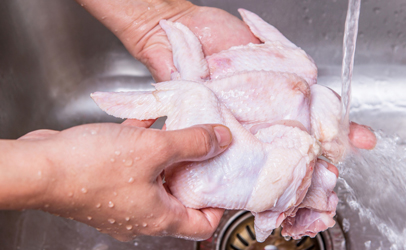Editor’s note: This opinion column offers a differing view from that presented by guest columnist Brian Ronholm in “Eschewing obfuscation on poultry slaughter line speed.”
Poultry slaughter would flunk HACCP 101. The primary hazards from raw poultry are the pathogens Salmonella and Campylobacter spp. FSIS visible poultry inspection does not yet detect those hazards. The visible conditions that FSIS inspectors can detect are based on 19th and 20th century paradigms that visible disease conditions are the public health hazards. Four decades of CDC data refute that.
 Regarding fecal contamination, in consumers’ kitchens, it’s not undercooking poultry, it’s cross contamination Here is one review: Luber, Petra. 2009. Cross-contamination versus undercooking of poultry meat or eggs — which risks need to be managed first? Intl. J. Food Microbio. 134: 21–28. That review is supported by other papers demonstrating the incompetence of ordinary consumers.
Regarding fecal contamination, in consumers’ kitchens, it’s not undercooking poultry, it’s cross contamination Here is one review: Luber, Petra. 2009. Cross-contamination versus undercooking of poultry meat or eggs — which risks need to be managed first? Intl. J. Food Microbio. 134: 21–28. That review is supported by other papers demonstrating the incompetence of ordinary consumers.
Additionally, much of the fecal contamination is invisible. When the defeathering machine removes feathers, the fingers compress the carcasses pumping out feces from the cloaca. The fingers then press some of that fecal material into the emptied feather follicles — where it remains invisible to inspectors.
A USDA Agricultural Research Service (ARS) paper supporting washing visible feces from chicken carcasses indicates invisible feces contaminate carcasses (Blankenship, L. C. et al. 1993. Broiler Carcass Reprocessing, a Further Evaluation. J. Food Prot. 56: 983-985.).
In the early 90’s, I proposed a research project for ARS using a chemical indicator such as coprostanol to detect invisible fecal contamination on beef carcasses. Coprostanol is used as a biomarker for human fecal matter in the environment. One ARS microbiologist commented that assay could destroy the poultry industry.
I replied yes, that is why I’ve emphasized beef. Jim Kemp later developed an assay for bovine feces based on a grass metabolite.

Those invisible feces and bacteria are the reason that ARS and others have indicated for over three decades that pathogens entering a slaughter establishment will emerge on the product. Here is a recent paper: Berghaus, Roy D.et al. 2013 Enumeration of Salmonella and Campylobacter spp. in Environmental Farm Samples and Processing Plant Carcass Rinses from Commercial Broiler Chicken Flocks. Appl. Env. Microl.79:4106-4114.
So, those are some of the problems. What are some solutions?
The pathogen problem starts on the farm, grow out, and the hatcheries. Solve that and I suggest that line speeds and visible issues are secondary. Here is an “ancient” paper on preharvest control: Pomeroy BS, et al. 1989, Studies on feasibility of producing Salmonella-free turkeys. Avian Dis. 33:1-7. There are many other papers.
The problem of implementing preharvest controls is cost. How do you create financial incentives for implementing controls?
I suggest let slaughter establishments bump up line speeds but only for sources that are free of the primary hazards, Salmonella and Campylobacter spp., or, at least free of the clinical strains (Salmonella Kentucky, if free of the virulence genes may be a probiotic). That would provide the financial incentive for implementing controls — and reduce the environmental public health burden of poultry production (many papers on this additional problem.
Happy new year and thanks for bringing this up.
(To sign up for a free subscription to Food Safety News, click here.)
